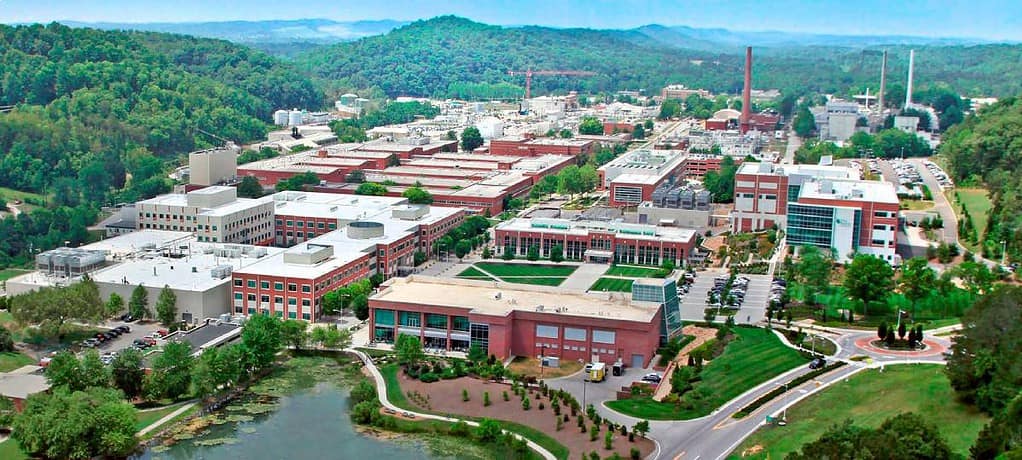Researchers with the Department of Energy’s Oak Ridge National Laboratory and Sierra Space Corporation have developed a new silicon-carbide-based thermal protection system, or TPS, for reusable commercial spacecraft. The TPS is composed of a tile face made from advanced materials and an insulative tile backing that, when installed on a space vehicle, will be able to withstand multiple launches and the extremely high temperatures of atmospheric re-entries over short periods of time.
The TPS composite material merges the high temperature and corrosion stability properties of silicon carbide with the high strength and high temperature consistency of carbon fiber. The two materials are combined into a low-density, low-profile composite thermal barrier that is critical for providing both insulative protection and stable flight dynamics.
“Keeping a consistent outer mold line is important for reusability,” said ORNL principal investigator Greg Larsen, referring to the need for a smooth exterior surface. “It keeps the aerodynamics the same to allow the vehicle to fly as designed.”
Larsen explained the properties of the new tile will help maintain the aerodynamic surface over multiple flights by resisting changes to size and shape caused by exposure to extreme heat. The TPS material’s light weight will help maximize usable commercial payload and internal vehicle volume.
The team leveraged 30 years of lessons learned from NASA’s Space Shuttle program to develop the new TPS. First used in 1981, the NASA shuttle orbiter’s TPS is still considered state-of-the-art thermal protection technology for space vehicles. The design called for each shuttle to be fitted with more than 24,000, six-inch by six-inch silica-fiber thermal barrier tiles – every piece custom made to fit an exact location on the surface of the lower portion of the spacecraft. The tiles were formed in a labor-intensive process by pouring water and chemicals into a mold and sintering the mixture at a temperature of up to 2,350 degrees Celsius to create the final shape. Technicians used a special adhesive to attach the individual tiles to the outer skin of each orbiter.
According to Larsen, while the NASA program averaged nearly five launches per year, commercial space flight is moving at a faster pace today. “The key to achieving a flight cadence that is driven by fast landing-to-launch turnaround times is reusability of the TPS,” he said. “The materials we are exploring will push the boundaries of reusability that translate directly to commercial viability for space-access providers.”
ORNL and Sierra Space have completed the first material-development phase of the project and have jointly applied to patent the new material. The second phase of the project will focus on developing an enhanced manufacturing process that will produce the insulative tile backing.
Sierra Space plans to use the new TPS on the Sierra Space Dream Chaser, the first-ever winged commercial spaceplane. The multi-mission spaceplane fleet is designed to transport crew and cargo to low-Earth orbit. The company plans to use the new TPS on the DC100 Dream Chaser that will carry critical supplies and science experiments to and from the International Space Station under a NASA Commercial Resupply Service contract.
TPS research is being performed at DOE’s Manufacturing Demonstration Facility at ORNL. The MDF, supported by DOE’s Advanced Materials and Manufacturing Technologies Office, is a nationwide consortium of collaborators working with ORNL to innovate, inspire, and catalyze the transformation of U.S. manufacturing.
About Sierra Space
Sierra Space is a leading, pureplay commercial space company at the forefront of innovation and the commercialization of space in the Orbital Age™, building an end-to-end business and technology platform in space to benefit life on Earth. With more than 30 years and 500 missions of space flight heritage, the company is enabling the future of space transportation with Dream Chaser®, the world’s only commercial spaceplane, and is bringing LIFE™ (Large Integrated Flexible Environment) to Low Earth Orbit with its modular, three-story commercial habitation and science platform. Sierra Space also builds and delivers a host of systems and subsystems across solar power, mechanics and motion control, environmental control, life support, propulsion and thermal control, offering myriad space-as-a-service solutions for the new space economy.
About ORNL
UT-Battelle manages ORNL for the Department of Energy’s Office of Science, the single largest supporter of basic research in the physical sciences in the United States. The Office of Science is working to address some of the most pressing challenges of our time. For more information, please visit energy.gov/science.
This Oak Ridge National Laboratory news article "ORNL, Sierra Space create new thermal protection system for reusable space vehicles" was originally found on https://www.ornl.gov/news

